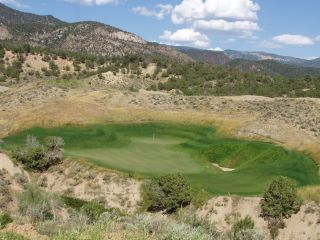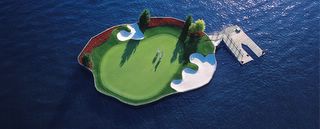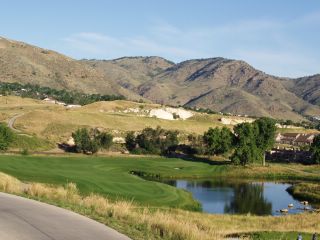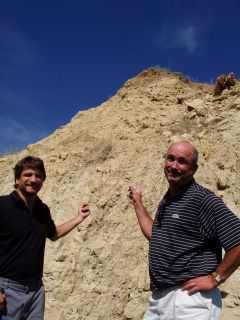Wednesday, August 31, 2005
NY Bar Association Lecture - Can you copyright a golf hole or "steal" the design of a hole?
There is CLE for this lecture. I'll give
an intro on design features architects use frequently
to create golf courses (redans, punchbowls, etc.
and compare U.S. courses. Architect Stephen Kay who
makes original courses and courses that look like
those of other designers or other courses will talk
about his designs. (He built Links of North Dakota,
Architect's Club and McCullough's Emerald Links.)
Bob Clarida will talk about a law
suit involving a course that advertises holes of other
golf courses, Pebble Beach v. Tour 18.There is lunch.
Call jay Kogan at 212.636.5465 or email
jturner@nysba.org to register.
--- JKogan0993@aol.com wrote:
> From: JKogan0993@aol.com
>
> include the cost, which will be $20 for members, $30
> for non-members.
>
> _________________________________-
>
>
> Committee on Copyright & Trademark
>
> DATE: Friday, September 30, 2005
>
> TIME: 12:30 - 2:15 P.M.
>
> The presentation will begin at 1:00 PM (promptly)
>
> LOCATION:
> Fordham University School of Law
> 140 W. 62nd Street
> Between Columbus and Amsterdam, just south of
> Lincoln Center. Three blocks
> from Columbus Circle subway station.
>
> Room 316 for buffet sandwiches at 12 Noon
> The panel starts at 1pm in Room 311
>
> PROGRAM: Chipping in from the Fringe - legal issues
facing golf course designers.
>
> On September 30, 2005 , the Entertainment, Arts &
> Sports Law Sections
> Committee on Copyright and Trademark of the New York
> State Bar Association will
> hold a luncheon program entitled "Chipping In From
> The Fringe."
>
> Speakers will include Robert W. Clarida of Cowan,
> Liebowitz and Latman,
> renowned golf course architect Stephen Kay ,
> designer of The Architects Club in
> Lopatcong, New Jersey, and Golf writer and
entertainment lawyer Jay Flemma.
>
> Can you copyright a golf hole? Are design features
> of golf courses scenes a
> faire? Are there issues of sculpture and
> three-dimensional works involved?
> How about trade dress issues? What trademark issues
> do golf course designers
> face, and to what extend can a designer "steal"
> golf hole and design
> features from other golf course designers?
>
> Anyone interested in exploring the edges of
> copyright, and examining
> how copyright, trademark and trade dress concepts
> can be applied to subject
> matter not typically viewed as entitled to
> intellectual property protection will
> find the discussion fascinating.
>
> In addition to examining intellectual property
> protection issues for golf
> course designs, our speakers will explore licensing
> and merchandising
> opportunities that may be available to the creators
> and owners of golf courses.
>
> Co-chairs: Jay Kogan and Neil Rosini
In Boston for the Deutsche Bank Classic? Play Red Tail By Brian Silva
RED TAIL GOLF CLUB
978.772.3273
www.redtailgolf.net
Par - 72
Excitement Level – 9/12
Diff. – 6/12
Conditioning – Four and ½ stars
Cost - $90 peak, $50 reduced
Yearly Memberships – Yes, $4,250 play anytime
$3,250 play M-Th
Value – Four and ½ stars
Overall – Four and ½ stars
Tournament 7006 73.9 138
Regular 6379 70.5 130
Senior 5654 67.7 119
Forward 5049 69.4 120
In the past ten years public golf in the greater
Red Tail surpasses all expectations. Every hole is memorable, except perhaps the short par-4 12th and no holes or holes that seem forced or over the top. Four sets of tees offer a fair test to golfers of all skill levels without the player feeling overmatched.
Contoured, slick slivers of greens guarded by fiendish drop offs into Donald Ross-like collection areas defend par well on the short par fours and frequently feature what one Red Tail course ranger described as “Sunday pin placements every day.” Finally, as every round at a Silva course is also a lesson in classical golf architecture features, players will negotiate punchbowl greens, saddle greens, modified Redans and hazards turned perpendicular to the line of play in the manner of Silva’s idols, Seth Raynor and C. B. Macdonald.
The front nine may be one of the best outward nines on the entire eastern seaboard. While many architects wish to offer an easy warm up at the first, Red Tail demands crisp contact and concentration on the first drive of the day – an intimidating cross bunker cuts obliquely across the fairway and must be carried to reach the landing area. Further, the shot plays over a natural hump, adding elevation to the challenge. Fade off the tee, but draw into the green, the player is required to exact various shot shapes right out of the gate.
The second showcases an original Silva design feature, the “Green Monster bunker,” a veritable pancake stack of multi-layered bunkers guarding the left side of the landing area of this dog leg right par five. (Two other examples of a mountain-like Green Monster stack of bunkers on top of one another are found at the par-5 ninth at Links at Hiawatha Landing and the par-5 fourth at Silva’s private version of Red Tail, Black Rock Golf Club in nearby Hingham.)
The third is a gorgeous modified Redan par-3 which plays uphill to a deep green. Take enough club to reach comfortably as the fairway slopes severely to the right and shots short or right will result in an awkward uphill 40 yard pitch to the putting surface. Players can take advantage of Silva’s intentionally designed “kick slope” short and left of the green to bounce the ball onto the green and take advantage of the hole’s natural contours to feed the ball to the hole. (There is another “secret slope” on the left side of the seventh green as well. “Shh…don’t let the secret out too much” Silva says with a grin.)
Silva loves punchbowl greens (see also # 11 at Hiawatha Landing) and gives us two at Red Tail. The first is at the uphill, yet reachable par-5 fourth. Better players can use the green’s natural contours to spin the ball to the day’s hole location for an eagle try.
The stretch of six through nine features a short-long-short-long combination of stellar par-4s. The sixth features the prettiest drive of the day, a long carry over a ravine with water left and trees right. The lake off to the left offers an idyllic view, but do not be distracted from the demanding drive at hand. The eighth measures a scant 306 from the Regular Tees, but the green is a mere sliver and slopes off dangerously on all sides. Chip shots here are every bit as dicey as at fabled Pinehurst No. 2.
The par-5 tenth is listed as the hardest hole on the card and may live up to its reputation. Bending hard to the left, climbing uphill all the way, and lined by trees on both sides which make the playing area particularly narrow, one misplayed shot will damage any chance for a par. The beautiful par-3 eleventh plays from an elevated tee to an elevated green set at the base of a steep hill. Shots short or right will either find a penal bunker or require a 40-50 yard uphill chip to a small green. Again, Silva leaves one side clear for short-knockers to bump and run their way safely to the green.
The finish is creative and memorable. After a beautiful drive from an elevated tee at the 400 yard 14th, the approach is uphill to a saddle green, more steeply sloped than its front side sister. 17 is the most popular hole with the players. From an elevated tee box, the cape-style hole begs for a long drive cutting the corner on this dog leg right. However, shots short or right find a waste bunker that looks straight out of
Finally the 18th is a reachable par-5 for the long hitter who can carry the crest of a hill, but the second shot will be played from an uneven lie (at best) to a green fronted by water. The entire fairway slopes toward the water, so even third shot approaches with wedges need to be precise. A front right pin position often suckers in greedy, imprudent players and hangs a round crushing big number if played carelessly.
Players of all skill levels equally love Red Tail for its beauty, fairness and inexpensive price tag. While swinging a "speed stick" in the parking lot of Pinehurst at the 2005 U.S. Open,
A registered member of the Audubon International Signature Cooperative Sanctuary, Red Tail features diverse flora and fauna, including deer and the red tail hawks for which the course takes its name. Ever the historians, locals are as equally proud of the site’s heritage as the former site of the
Luckily for Silva, he was able to use the natural flow the fairway followed over these subterranean structures to fit the shot shaping requirements he had designed for the holes. Two great examples are the draw receptive fairways at 8 and 10. “How about that!” Silva beams, “I was forced into certain parameters by site considerations and environmental limitations and it came out great. I probably would not have imagined that hole had the outside factors not been imposed on my work.” Perhaps that is also the hallmark of a world-class designer – making lemonade when the world hands you lemons.
Great architects want to experiment. Like Strantz, Silva is intrepid and gleefully rips the rug out from under player’s expectations. Like Dye he is fearless. And like Raynor he is true to the game’s roots and employs a broad and deep bag of design features. He is neo-classic, taking the old for a canvas and boldly brushing it with new strokes. As such, he is both reflective upon the old and spontaneous, challenging us in two ways. First, we grow to accept novel or revived design features. Second, by learning about golf design we play better.
Silva has a unique, highly personal voice; an important and well respected one. But most importantly and interestingly, he has a world class sense of Architectural Echo. He takes old design features like redans and punchbowls and brings them into the 21st century. Also, his designs resonate from the time they are built with little diminishment in respect or popularity. .
A truly great travel destination either changes the traveler forever or validates one of the traveler’s long-held beliefs. A great round of golf does the same. Silva validates two critical concepts for golf and golfers. First, we are living in the golden age of architecture, building the best courses now and only getting better, more imaginative, and more intrepid. Second, we should not be afraid of changing what the mainstream accepts as “a golf course.”
Golf is not a game of perfect, but golf is also not a game of easy. From punchbowls to pancake stack bunkers, from a
Tuesday, August 30, 2005
Lakota Canyon Ranch and a hole in one for a Texan
I'll write more tomorrow, but Jim Engh outdid himself (tough to do...I know! But he did), with the amazing Lakota canyon ranch.
Tom Doak wrote that undulation is the soul of the game. Engh did that in spades. I have walked 230 places and I BARELY finished LKR. Its gorgeous. It's got strategic options. It's inexpensive. It has it all, jumoping to the top of my all time list. Just take a cart or caddy cause if you walk it yourself, it is a murderous thing. Run don't walk to this fantastic course and stay for a few days. More to come in a couple days, but meantime...
CONGRATULATIONS to playing partner Dick Kristinik from Houston, TX who incredibly aced the long 17th from a damn near impossible pin placement. (See pic above). The skinny - 204 yards and a 7-metal. The witness was his buddy Baker McAdams, a fellow Lone Star Stater. Dick shot a blazing 78.
Alsdo, happy birthday to Lakota Head Pro John Pallen.
CONGRATULATIONS! - Lee Sossen and Michelle Ramoni and a Caddyshack moment
We interrupt this golf trip to offer hearty congratulations to two of the AWITP extended family.
First, you read here about my buddy Lee Sossen who won the very first biatholon he entered back in May. Lee has done it again, winning another nationally reknowned biatholon event this weekend in the Northeast. Moreover, Lee got named to the US national biatholon national team and is headed to Australia to compete later this month. A stout heart and a true sportsman in the real sense of the word, Lee will represent our beloved red, white, and blue the way athletes are intended, with dignity and class. Go Lee! U-S-A! U-S-A!
Next, remember this name! Michelle Ramoni. "Aspiring" actress no more, this tall drink of water with the most gorgeous head of naturally curly red hair you ever saw just landed one of literature's most coveted roles. Michelle will play Puck in the NYC performance of Shakespeare's A Midsummer Night's Dream. The performances are slated for later this fall. Details to follow. An already accomplished sketch and stand-up comedienne, watch for Michelle's future on stage and screen.
Last, welcome to the extended family to Bennie from Vegas and Mike from Denver. Good luck with those quadruplets Mike;) All you dad's out there, think about that for a minute. Golfer by day, Bennie is a pastor by night shining the light of God in sin city. That's gotta be as tough as quads too;)
That does remind me of a Caddyshack moment...
Bishop Pickering: You outta come down to our new Youtheran Center, Danny.
Danny: I've often thought of entering the priesthood
Wiseguy caddy: I've often thought of becoming a golf club...
Monday, August 29, 2005
RED HAWK RIDGE G.C. - Castle Rock, CO
RED HAWK RIDGE G.C.
2156 Red Hawk Ridge Drive
Castle Rock, CO 80109
720.733.3500
Architect: Jim Engh
Par 72
Excitement Level - 8/12
Difficulty - 6/12
Conditioning - Four stars
Cost - $75 high, 3PM twilight $50
Value - Four stars, (four and 1/2 at twilight)
Overall - Four stars
Castle Rock, Colorado has four superlative course all within shouting distance of each other. The public access gem is Jim Engh's Red Hawk Ridge, an excellent sister course to nearby Fossil Trace, a mere half hour to the northwest.
Built in 1999, Red Hawk is Engh's first solo public course. Much of Engh's design philosophy was forged here. First, like Fossil Trace, Red Hawk is a muni. Since it is owned by the town of Castle Rock, it is friendly and affordable. Next, Engh shows his propensity to break the routing mold which stifled design for so long. There are five par-3s and 5 par-5s (just like Fossil Trace.) Both courses also end with reachable par-5s guarded by water hazards. Once again, Engh makes the most of the strunning natural setting by setting tee boxes on pulpits overlooking panoramic views and setting green backdrops against a variety of gorgeous scenery.
Speaking broadly, the best holes are on the back. The driving-iron and pitch 8th with its green set at the base of a volcano shaped butte can be driven, but the shot from the tee is totally blind, uphill 100 feet, and must carry a dense scrubland of trees and a blind bunker to a pedestal green. "I'll let someone try to reach one of my par-4s under regulation, but I'm certainly not going to make it easy for them" Engh says with conviction.
Starting on ten, strap yourself in because every hole is excellent. The biggest attribute is Engh's Mackenzie-like talent for setting the greens against a gorgeous backdrop. An arroyo crosses in front of the green guarding the tenth, with its green set against the town below in the distance. The green at the par-3 11th sits in a bowl beneath serene native grasses. 12 and 13 climb toward the top of the property along high ridge. "I set the the par-5s in the valleys below the ridge lines and used the ridges for the par-3s. That's where they fit most naturally on the land."
One exception to the "ridge rule" is the 75 foot downhill drop shot at the scenic par-3 14th, which is guarded by a stone-lined bunker and a scrub filled drop behind.
The most controversial hole, the 528 yard par-4 (528 yard par-4!) 15th - 465 for us mere mortals - aroused the interest of the USGA. At first they thought the free-thinking Engh - who has more than a little of Mike Strantz's creativity in him - had pushed the envelope to far. But since it is all downhill and set at 6500 feet above sea level, it can easily be reached with a drive and long iron or fairway club. "Plus the prevailing wind can aid players too" Engh said. The hole actually works quite well and is a stiff but fair challenge. The USGA came around to his way of thinging as well.
The finish, 14-18 is world class featuring a 5-3-5 finale with loads of strategic options to keep everybody in the game for their match.
If there are any places where Engh got a little puckish, the back right pin placement on four (four paces of green and guarded by water) and back left on 17 (again, a target maybe eight paces in diameter - four on each side of the hole.) Those spots are tight, but playing devil's advocate, both holes are short and players should have pitching clubs or 8-9 irons in their hands.
Being a municipal course, Red Hawk gets singificant play and foot traffic on the greens can make the front nine a little bumpy. But overall, conditioning is superb for a muni. The high rate of $70/75 makes is pricier than Fossil Trace, but at $50 for twilight, it's still a good bargain. Here's hoping management will extend twilight from 3PM to 2PM or even 1:30. It's a must play if you're in Colorado and is well worth a long drive or even a stop for your week long golf vacation.
HONORABLE MENTION
Just a block away, private course Castle Pines (home to the International and the hopelessly unpopular Modified Stableford scoring system...have YOU ever played Stableford in one of your matches?) sits near Engh's ultra-exclusive but gorgeous Sanctuary G.C. Sanctuary is so private it has only one member, the CEO of Remax.
The other public course in the neighborhood, Castle Pines Ridge is a well maintained if predictable Tom Weiskopf deisgn which bears more than a passing resemblence to his good work at Troon North. The condidioning and especially the greens are pristine...five stars. The bunkering is typical Fazio-esque cloverleafs. One bunker actually had FOURTEEN individual noses.
The best holes are the narrow uphill risk reward 6th, the long par-3 7th, the driveable 8th and the par-4 9th which is so severely downhill, you can putt to the green form 150 yards out. The back is drop dead gorgeous, but is a mix of world class holes on one hand and some unworkable holes on the other. Expert golfers love the narrow, uphill long par-4 10th, but I find it too claustrophobic. The gorgeous 245 yard par-3 12th may be the best "Use a driver par-3" Weiskopf ever designed and is worthy of inclusion in a list of the country's best golf holes as are the fantastic par-3 17th and the incredible uphill par-4 18th with its drive of a cliff over an arroyo filled with sandstone monuments. The scenery is breathtaking. However 15 and 16 are a poor effort. As houses crowd the course at many points, these were where Weiskopf had to endure the greatest tradeoffs in the routing.
Last add - word is the course may replace the dreadful thick mud-colored sand in the bunkers. Imagine playing out of dry sand that feels as though it was sopping wet. To the courses credit, they do recognize its few shortcomings and makes excellent efforts to constantly improve conditions. It shows in the stellar fairways and greens. CPR is one of the few courses that is worth a $100 price tag (except for 15 and 16), and is an even better deal at twilight.
Sunday, August 28, 2005
COEUR D'ALENE GOLF RESORT - Coeur D'Alene, Idaho
On the
208.667.4673
www.cdaresort.com
Architect: Scott Miller
Par - 71
Excitement Level – 11/12
Difficulty – 5/12
Conditioning – Five stars
Cost - $185 peak, $99 reduced
Value – Five stars
Overall – Four and ½ stars
Resort 5899 68.2 117
Senior 5428 70.4 114
Forward 4446 64.4 104
The sky is azure, the fairways are hunter and the water is crystalline. Many resorts boast an inflated price (sometimes $175 or more), but If ever a resort course were worth a $150, it's CDA. "When you look at a picture, you cannot believe the sky is that blue and the grass is that green, but it really is" said player Jim Donovan, a traveler all the way from New Hampshire.
CDA has suffered two knocks from purists. Many think it is too easy at it's mere 6307, yards, but as par is 70, many of the par-4s exceed 400 yards and the knock loses some of it's value. Second, the course's main draw - the incredible floating green at the par-3 14th - a huge island in the middle of the lake that is attached by the mainland by an underwater system of pulleys that move the green from side to side and to and from the lake edge has been vilified as a gimmick. You actually have to take a boat to the green. A digital readout on the tee shows the day's location - anywhere from 100 - 175 from the men's tee. The ladies have a special peninsula tee a little further in the lake.
Happily, most see the 14th as a fun addition to a solid and interesting golf course. Wide fairways offer multiple corridors of play for all skill levels. Most routes to the greens are open so novices can play the whole day without being overwhelmed.
Other interesting holes include the par-4 2d which has a serene green backdrop of the shimmering lake, the strategic par-4 11th with Furman Creek running down the left side before cutting sharply in front of the green, and the short par-4 13th with the lake on the left and two bights cutting into the fairway landing area and in front of the green.
Saturday, August 27, 2005
Thursday, August 25, 2005
Far West Golf Travel Swing - Summer 2005
Starting tomorrow, the A Walk in the Park public golf travel team will being playing eight consecutive great western US public golf values by more than four preeminent architects. There will be interviews as well. Stunning settings, brilliant strategic designs and an unbeatable price will all combine in courses you should run to play for your next vacation.
See you all from the road.
Tuesday, August 23, 2005
Golf Travel Tour - Summer 2005, Great Courses and Eden Holes
The public golf value airplane is fueled up and on the runway, which means Tour Journal reports from around the U.S.A opn some of the best public golf values. This fall we will visit New Mexico, Colorado, Nevada, Cali, Texas and The Midwest. There will also be interviews with golf architects coming soon as we report from the road.
The summer "Honor Roll" of great golf values is below:
1) Pine Needles, Pinehurst, N.C. At $95 and with cheap suites screaming to be filled, Pinehurst (a.k.a. Golftown, U.S.A. offers a well conditioned U.S. Women's Open layout for less than any casino or pricey resort and it's corresponding strategy-light design.
2) Fowler's Mill, Cleveland, OH - A classic strategic test. Pete Dye's first major work post-Harbour Town. A creek bisects many fairways, wreaking havoc on club selection and picking out the right line. A great thinking man's course. You can get on for $62 or less.
3) Firestone Farms, Columbiana, OH - A really diverse variety of hole styles and lengths. Dry conditions were prevelent early in the summer, but as fall comes in, water levels in the MW should increase. At $44 its a steal.
4) Links at Hiawatha Landing, Apalachin, NY (Binghamton) Still the best public course in New York State outside Bethpage and by far the best value. ($45) Mark Mungeum and Brian Silva wove perpendicular hazards and other strategic holes onto a true links landscape. Skip the pricey tourist traps and never leave except to alternate with nearby Conklin Players' Club and Greystone.
5) Red Tail, Boston, MA - Silva's best course yet was in pristine condition in high summer. At $55 twilight, take a weekend trip here.
6. Royal New Kent, Providence Forge, VA (Williamsburg) - $60, but most of the time much lower. Mike Strantz's amazing tribute to Royal County Down (NO-Its NOT a pastiche), is a stern test. Play it when you think you are good. Bring a tourniquet, a canoe, a camel and a priest.
7. Sedona Golf resort, Sedona, AZ - Here's one for "looky-loos" - its short, easy and sits amidts the beautiful striated red rock formations of Sedona. Come here and expect to shoot a career round - the course sits 4000 ft above sea level.
8. Beechtree G.C., Aberdeen, MD - Another low-key Tom Doak winner. $62 at twilight. Doak leaves open routes to all greens save one (the par-3 2d). A great mix of short and long par-4s. No slave to symmetrical routing, the back to back par-5s at 7 & 8 are terrific...one a true three shotter, and one reachable by most with two stiff fairway metals. The par-3 thirteenth may be the best "Eden" hole Doak ever made.
"Eden" hole - a long par-3 in the style of the 11th at St. Andrews. Deep bunkers guard either side and the green is sloped to accept qa running approach.
Friday, August 19, 2005
Pine Needles Golf Club and Lodge is a great value
Pine Needles Resort, Pinehurst, NC
Par 72
Architect - Donald Ross, restoration by John Fought
Excitement Level - 8/12
Difficulty 5/12
Cost - $95 in high season, many half price packages available
Conditioning - Four Stars
Value - Four and One-half stars
Overall rating - Four stars
Here is a terrific example of great value. You can play a course which has hosted to U.S. Women's Open's and is preparing for the third in 2007 for around $45.
Ross' greenside contours are nowhere near as severe as at the Pinehurst Resort, but a good mix of par-4 lengths, alternating shot values and varied green complexes make the round interesting, strategic and fair for all levels of play. Conditioning was terrific. The old style Lodge is quite confortable. Mix in a day at Tobacco Road and The Pit and you have another trip to make to Golftown, USA in addition to the pilgrimage to play No. 2.
Atunyote Golf Club at Turning Stone, Overpriced, Strategy-light and no Architectural Echo
Architect: Tom Fazio
Par 72
Excitement Level - 5/12
Difficulty - 7/12
Cost - $175, no reduced rates
Design - Two and 1/2 stars (all ratings out of seven)
Natural Setting - Two and 1/2 stars
Conditioning - 6 stars
Value - One-half a star
Overall rating - One and one-half stars
The best example I have seen this year has been Brian Silva’s private design Black Rock in his home town of
THE LATEST GOLF MAGAZINE RANKINGS
Additionally, Golf Magazine’s top 100 lists came out this week and show heavy emphasis on strategic layouts, passing over many overpriced contrived layouts which look pretty, but like the proverbial platinum blonde, ultimately fail to satisfy long-term .
Atunyote (and the rest of the Turning Stone casino courses) were absent. Notice I did not say conspicuously absent, for most of the course conesseours already saw through Atunyote’s flash and hype. (Funny, but the cheapest and underhyped course, Rick Smith’s Shenandoah is the unanimous pick by experts as the best course at the resort.)
Since there are no advanced design features, the course is devoid of architectural echo.
Because the course looks pretty and because the nearest outstanding daily fee course is two hours away in
“WE’RE AIMING TO HOST A MAJOR”
Those who engage in any criticism of the course may find the service much cooler though. Two quotes are most disconcerting. In touting the course’s playing host to the Club Pro Championship in 2006, the media director responded to my earlier column on the course by saying Atunyote was on par with “Pinehurst,
Undulating green complexes with devilish chipping angles? Random bunkers confounding long bombers? Plenty of strategic options? A variety of architectural features? Yeah Atunyote, you are right.
You have nothing like that.
One well respected international guide to golf courses frequently rates such Disney-fied, strategy light designs very low on their ten point rating scale. They describe an absolute zero as “A course so contrived and unnatural that it may poison your mind and which I cannot recommend under any circumstances. Reserved for courses which wasted ridiculous sums of money in their construction and which shouldn’t have been built in the first place.”
Friday, August 05, 2005
Jay Flemma interview snippets with Brian Silva - in his own words
JF: Tiger, Phil, Ernie and Vijay all challenge each other to a one hole, winner take all televised $1 Million Shootout. What public hole of yours will you take them to play?
JF: And amateurs sometimes make the mistake of being too greedy. Their eyes are bigger than their R7.
Silva: Yes! And they end up slicing it dead
JF: How did people initially react to the green pitch on your redan at Black Rock
Silva: You should have heard the crying!
JF: I’m sure.
Silva: The green slopes away from the tee box!!!!” [he said in a shrill mocking voice.] Why does my lofted shot at the pin go over the green? I’ve never seen anything like this!
JF: Is that the craziest or zaniest moment you have had to deal with as an architect?
Silva: Here is the dumbest "this can't be happening moment" ever. I was working on a project with
two partners. One was the money guy, the other the site guy. The money guy made his infrequent
visit to the site and seemed predisposed to make sure he put me thru my – or perhaps it was his
paces. We came up to a hole that played over/around a wetland. I explained that the back tee
would play to about 200 yards, totally over the wetland. I next pointed out the little peninsula of
dry land – a natural formation – that jutted into the wetland about 150 yards from the green.
I mentioned that this would be the location of the middle tee. It required less carry and also
approached the green at less than the perpendicular afforded by the back tee. I then pointed
out another small peninsula – a natural formation - that jutted into the wetland. Here is where
the forward tee would be and would play to about 100 yards and featured a nice angled approach
that required even less carry. When I paused, the money man said, "Why so many tees?" I told him that it was a par-3 and
that par-3 tees varied both the distance and the angle of approach, playing shorter and with a
more favorable bite off angle as you worked from back tee to front tee. The money man repeated himself, "Why so many tees?" I told him that it was a par-3 and that
you needed a good amount of tee space so that divots could be repaired and given time to heal. He then said, "Why don't you just use a rubber mat.” Among other things, I thought, "This can't
be happening to me." JF: What else frustrates you as a designer? Silva: Of all the frustrating preconditions that plague golf design in America
to “dumb down” golf holes to their mind-numbing easiest. That utterly obviates any chance of
strategy on a golf hole. Sadly, that is how so many designs become so entirely milquetoast.
With the, what is it 18,000 courses in America
like every other course and why can't some be unique. For example, I really don't understand the
few negative things I hear about Tobacco Road. It is fun. It is different. It is aesthetically
invigorating. What is wrong with that? Plus it accomplishes all its magic without the benefit of a
seaside setting. How amazing is that. We are supposed to be in a somewhat free discipline.
I sure don't want my courses to look like everyone else’s. Southboro , Mass.
Lets see, I also like Talking Stick North in Arizona Desert Forest Monday, August 01, 2005
Three pack of Northeast golf courses and a Poll Question
First things first: here's the poll question:
Bulle Rock or Beechtree? Its time for a side by side taste test of Maryland heavyweights. Like two champion prize fighters trading haymakers, Tom Doak's classic and beautiful minimalist design at Beechtree slugs it out admirably with Pete Dye's strategic gem at Bulle Rock. Send in your opinion...I'll be writing about it late this week.
In the meantime, here's three nice little layouts worth a stop for funsies.
Orchard Creek Golf Club in Altamont, NY (www.orchardcreek.com) may not be the course around which you plan a vacation, but at least is reespite in the golf-dry corridor of I-87 from Sleepy Hollow to Lake Placid. Set amid flowering apple orchards, the course is a quirky municipal target test. In a strange bit or reverse synchronicity, the holes that don't appear to work to the trained eye, actually are the best, while the "signature hole" and other more popular holes actually fail from a strategic standpoint. For example, there are several blind drives, which dont bother me, (Hating blind shots is for chumps), but annoy those preconditioned by less imaginative writers. Next, the gigantic hogsback - large enough to deflect ANY putt on the semi-blind par-3 sixth actually WORKS because - like the sand trap on the green at the sixth at Riviera, the green is pitched so far from left to right you can putt the ball AROUND it. However, 16 is an overly cliched penal target hole with water all along the left and in play off the tee on the right. Yawn.
Still, the course is cheap. Conditioning is average for a muni, but there have been droughts all over the NE this year.
Links at Gettysburg is an excellent layout in the old historic town. many strategic par-4s shuffle between scenic, sparkling par-3s. Two target stretches...specifically number 7 and 13-15 get too penal to vault the course to A+ status, but this one is a keeper for a vacation day or a weekend trip. Pretty for lookyloos, yet challenging to experts, there are many holes offering strategic lines of play around a variety off hazards including rock walls, red rock grottos, water and cross bunkers. The price is nice at roughly $60.
Fowler's Mill outside Cleveland is the best of this week's crop. A Pete Dye design for around $50. Terrific strategic holes in the same vein as Harbour Town. See my article below for more details.





















